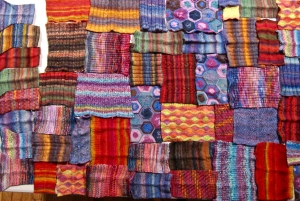
Hundreds of knitters in Ravelry’s annual Tour de Sock speed knitting competition know who Kirsten Hall is: she’s the sock designer they’ll encounter after they survive the first couple of stages, who will challenge them with mental and needle gymnastics that will reward them with beautiful, ingenious socks. Her patterns are long, long, long, but are perfectly crafted. The numbers and math are accurate. The verbal instructions mean exactly what they say. How does she think of those crazy maneuvers? How does she get everything right? I invited her over to my house recently and got her to talk.
Abby: When I do one of your patterns, I know I’m about to learn a lot of stuff I’ve never seen before, and I’m not an ignorant knitter. But you do maneuvers I’ve never seen before. So I’d like to cover where you get your moves. Another thing that is really outstanding about what you do is that the math’s always right and that if I just literally follow your instructions, it’s going to work out. That’s extraordinary.
Kirsten: That’s the test knitters. But usually it’s right in my head, and when the pattern gets revised or updated… like Diamondbacks, I just recently sent out two updates because I made a change to the heel after all the test knitting. A couple of persnickety, intrepid, detail-oriented people found a couple of number errors, but we got them fixed. And it was usually me putting the number in the wrong hole. I mean I had the right numbers but I put them in the wrong spot. I’m appreciative when someone writes to me to tell me that, because, A: they’re saving me from all the other people who are going to contact me about it later, and B: they’re saving everyone else who has to go through it! I don’t want anybody to have to second-guess themselves. People will always think it’s them, they don’t think it’s the designer. It takes a little courage to contact the designer.
Abby: I know your instructions are going to work out! That was what I loved about Far Into the Forest [left photo], and Diamondback [right photo].
Kirsten: Tour de Sock helps, you know! When you get 400 people knitting them, by golly, you find all the mistakes!
Abby: I guess so! How did you get involved with Tour de Sock?
Kirsten: That was an accident. They had a designer drop out at the last minute a few years ago, and they were looking for sock designers, and they just contacted me, and I happened to be working on the brioche socks at the time for myself. I wanted to figure it out for myself. I was learning how to do brioche, I was wanting to apply it to socks. They said, do you have a pattern, I said, well, I do, but you’re not going to like it. I gave it to her, and it was the one that sort of overwhelmed everybody and upset them and made them write lots of notes about, you’re killing us all. And I had to put out a public apology!
Abby: How many years have you been doing Tour de Sock?
Kirsten: I think it’s been four or five years? And so anyway, I did it then, and they stood by me, they were so nice to me, they’re just the nicest people. And so ever since then, I just write to Sarah, usually in the winter, and I say, want another one? And she always says yes.
Abby: And you’re kind of deep into the process, as you get harder and harder, you’re like Stage Three?
Kirsten: They don’t put me in the first stage usually. I’m usually near the end. And the Finnish people get all excited. I don’t know what it is about the Finns. They’re amazing. I can’t believe how fast they are! I would hurt myself.
Abby: I did three pairs of these socks, and I couldn’t do a sock in less than five days.
Kirsten: I couldn’t either! And it’s my pattern! They can read through a pattern so fast and understand it so fast!
Abby: So how do you get to these maneuvers that I’ve never seen before?
Kirsten: Necessity. Let’s see… Far Into the Forest, actually Natalia Vasilieva/skeincharmer and I worked along the same thoughts at the same time. But I was looking at brioche and trying to figure out how to do brioche in a sock without making people do brioche, and so, stranding. And so I was doing brioche-like increases and decreases à la Nancy Marchant. This was very similar to some of the patterns in her second book, where she had this whole encyclopedia of two-color patterns that really lend themselves to stranded knitting. Except if you get too many increases in a row then you start getting a very warped fabric. So you have to space them out. This one, the Diamondbacks, I was trying to knit a different sock altogether. And at some point I was turning corners in a funny way and saw the upside-down diamond shape. I know how to make this V-shape, but the mountain shape, stacking it on top, was shadow-wrap short rows. It was an accident. I somehow accidentally made that shape.
Abby: So you do it because of that knit-front-back and knit-back-front maneuver.
Kirsten: It was the yellow one I sent to you. It was a complete failure. Here’s the problem: I would make a prototype and then I’d reclaim the yarn and rip it out and make something else, because I’d figure, oh, that didn’t work, I don’t need it anymore.
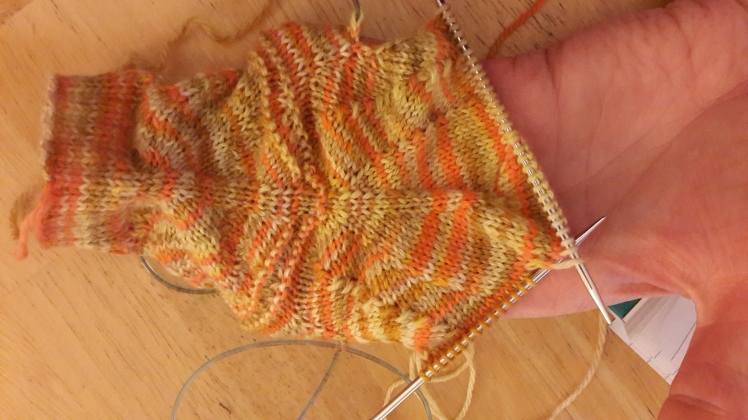
Abby: Not knowing that you’re about to be interviewed.
Kirsten: Sometimes I take pictures and sometimes I can even find the pictures. Anyway, I had this miniature version of a sock knitted like a baby bootie. It worked as a baby bootie, small sized, but when you enlarged it to grownup size, it pulled and twisted on the fabric in a weird way and the sock was going to be impossible. It was very geometric, it was very origami-like, and there was that point somewhere, and I said, hey! That does neat things with stripy yarn.
Abby: It sure does!
Kirsten: So then it was knitting back and forth and I was trying not to replicate the Diversion pattern that was on Knitty, which was sort of like Lizard Ridge, you know? I didn’t want to do that, I wanted points, I wanted diamonds. I was so thankful when people started thinking of the turtle, the terrapin, the diamondback terrapin turtle, because I was thinking of a snake and people don’t like snakes. I think they’re beautiful, but it was upsetting to people. Someone said, is this about a turtle, and I said, oh yeah, yeah, it’s a terrapin. It’s a Maryland thing, so yeah.
Abby: Absolutely! Go Terps! [nickname for the University of Maryland sports teams, the Terrapins]

Here we start talking about my adaptation of the Diamondbacks Socks stitch pattern to a garment shape. Below, my yarn and two sleeves. I used the blocked one as my gauge swatch.
Abby: I’ve been hanging onto this yarn for about three, four years trying to figure out what to do with it. I collected like four skeins of it, I could make a coat out of that.
Kirsten: What size needle are you using?
Abby: The cuff is zero, the rest is 2. My gauge is 6 stitches to the inch on the plain knitting and this [the diamond motif] is about two and a half inches. So I’m measuring it by how many units, and the plain knitting is by how many stitches to the inch. So I’ve got my numbers. Everything I need for garment shaping is included in the maneuvers of your sock pattern.
Kirsten: Fantastic! I hope you document it well so I can copy it.
Abby: OK! All of the maneuvers are in your pattern. Because you give the start of the triangles, you give instructions for ending the diamonds.
Kirsten: I don’t know if you’re turning a corner for a shoulder or making a sleeve cap?
Abby: It’s going to be a yoke. And your interrupted diamonds—
Kirsten: You can put whatever you want in the middle of it.
Abby: You can make it work for any size. So I know that I have 24 stitches here [at the sleeve’s armpit] and that’s going to be the same for the body [at the armpit] so that I can just graft. And I know that I need an even number of motifs for the body for symmetry.

Kirsten: Are you working in the round for the body?
Abby: Oh yeah. I figure that in order to get the circumference I want with the ease that I want, I need 14 of the diamond motifs.
Kirsten: And you know that from working the sleeve as a swatch.
Abby: Yup. And I also know that I want to have a little bit of A-line shaping. So I know that I’ve got seven motifs in the front and seven in the back, and I want to have 10-ish extra inches. And the yoke, I’ll just alternate interrupted diamonds and decrease them away. And then when I’m done with that, turn the even numbers into diamonds alternated with plain knitting until I’ve got my neckline. And you know what else I’ve found? Just how forgiving this pattern is once you know what you’re doing with it.
Kirsten: Oh, if you make a mistake somewhere along the way. As long as you keep the numbers right. It’s OK as long as you know what you’re doing and know when to do the shadow wraps.

Abby: I’d forget my last row and I’d end up with 18 stitches instead of 20, and so, oh well, I’ll just do that row right now. And nobody will ever, ever see it!
Kirsten: The only way it would ever show would be if you were doing some wonky thing where you were alternating yarn colors and trying to get specific triangle-type shapes.
Abby: You know what else I discovered? You can’t even see the plain rows, so if I want to raise the neck, just add some short rows. This is the most infinitely adaptable pattern!
Kirsten: I wouldn’t have seen that! That’s really cool. It’s like there’s micro engineering and macro engineering. I think I’m micro and you’re more macro.
Abby: Is that what it is?
Kirsten: You can take these pieces and put them together and I fiddle with how to turn a corner and how to make things look tidy, di-di-da-di, little tedious details. I like everything to be nice.
Abby: I can’t create a stitch pattern. But I know how to use it when I see it.
Kirsten: I think, like Barbara Walker, you can tell when you read her stuff, she was just messing around and one thing leads to the next, like what if I did this stitch but did this instead of that. I do a lot of that. I make a lot of wrinkled, wobbly, useless… like go through a whole skein of yarn making a big long scarf-like disgusting mess that I rip out later. But I learn something from it, and if it turns into something good, I write it down and take a picture so I can remember how I did that. I did that making seashells, the sock book that came out by XRX [Think Outside the Sox, which features three of Kirsten’s sock patterns]. I made like a 10-foot-long string of seashells until I got the one I wanted. I kept graphing each time.

Abby: Your instructions are very precise. How do you get that?
Kirsten: I was a technical writer, briefly, right out of college for a computer hardware company… So I did a little technical writing for a fax modem, remember what those are?
Abby: I remember.
Kirsten: I’d have to go talk to the engineers and say, tell me how to install this, tell me how to install the software. Not that I didn’t know how to do it, but I’d ask them to tell me how to do all the steps and then think of every stupid thing someone might do wrong, every stupid thing they knew anybody ever did wrong. So I wrote instructions. They were simple, how to install the software, what it might do next, what the pictures were, then I’d have to get somebody from some other department to read them and follow them and see if they work. It’s exactly like writing a knitting pattern.
Abby: So, being a technical writer about fax modems was good…
Kirsten: It was good for something in the end! It was a brief chapter that… I don’t know if I learned anything doing that or if it just brought out the natural nerdiness and persnicketiness. Probably it’s natural nerdiness and persnicketiness.
Abby: Well, an ability to put yourself into the position of the person who is not inside your head and who needs to be able to figure out some very specific instructions.
Kirsten: You know, that person is best found by test knitting. I mean, I do the best I can, but every single time a pattern is tested, somebody has some bizarre way of interpreting things. When they explain it, it makes sense they thought that way but I would never have predicted it. I couldn’t do it without test knitters.
Abby: Yeah. When I’m following somebody else’s instructions, it takes me a really long time to figure out where I’m supposed to be going with this, what is right. Because I lose track of numbers and I need to have some visual signposts to clue me in about where I’m going with this thing.
Kirsten: Yeah, I’m very visual. Some people are the opposite, some people prefer to read computer code, so I feel like you have to provide a little of both, and then you end up with a lot of stuff. So I try to break it into chunks.
Abby: Well, yeah, your patterns are long.
Kirsten: I’m getting better at… this is something you have to think about but maybe not right now, so I’ll put it on the side, an outtake you can read, otherwise there gets to be a lot of crud to get through and then people don’t read it.
Abby: Yeah, what I discovered I needed to do on the first time through with Diamondbacks was pay attention to those two lines of instructions for each tier! Otherwise I was going to be ending and starting in a completely wrong place.
Kirsten: A lot of people did that. A lot of people got to the end of the first row and didn’t go back and do the second line of instructions. If I was going to rewrite that, I’d say, now don’t forget line two! Go up and do another line, you’ve just completed one round, you’ve got to do another round.
Abby: And that’s how I know it doesn’t make a big whole lot of difference when I skip round two.
Kirsten: Good! There was the jog, a lot of people skipped the jog and they’d stack the diamonds point to point on top of each other and start creating a cube. That’s what really fascinates me. To me it’s just intuitive not to stick one point on top of another point. A point goes in a valley. It’s not intuitive to everybody.
Abby: Yeah, it took me a little… pretty soon I figured it out. That was where your diagram was helpful, because then I could see, ok, these words aren’t quite making sense to me at the moment but I know that I’ve got to start up at the peak, go down to the valley, build the next set of peaks and end up at the peak off to the left. Now I don’t even look at the instructions.
Kirsten: Once it starts to make sense.
Abby: Of course, how many peaks have I made after six socks and a sleeve. I’ve done this before! I think it’s part of my DNA now.
Kirsten: It probably is.You can do it in your sleep. But there was one thing in your blog, where you say until you know the overall goal, the whole point of this thing, what we’re trying to do, then all the little details are useless. I forget what you were describing.
Abby: My learning process.
Kirsten: Which I feel like I’m the same way. Which was why history class was so hard, you’re getting this series of dates and data, and then you’re wondering, what’s the point, I’m not going to remember any of it until I know what the point is. It’s just, collect and then put it together, which is what my husband does. He’ll collect and collect and collect until eventually it forms a pattern. “Oh, there it is!” But that only works if you remember all the stuff you’ve collected. I didn’t keep it unless it seemed valid at the time. Reverse engineering is easier for me. I’m a deconstructionist.
Abby: I know that I’m not that much of an engineer. But once I understand the structure of something, I can take it to places that other people can’t.
Kirsten: So you’re a designer then. That’s design.
Abby: Yeah. But I wouldn’t be able to create this pattern.
Kirsten: Maybe not the original little building blocks. But you can take them and do something with them. I think that counts.
Abby: And I guess it’s unusual enough that people seem a little mystified by it, but it seems quite logical to me.
Kirsten: A lot of people do not modify patterns at all. Or rebuild from them.
Abby: I will follow a pattern in order to take something out of it and reapply it.
Kirsten: Which is respectful. How does this work, what does it do, ok, there. I think that’s nice.
Abby: I don’t want to reinvent something that someone else has already done, probably better than I can do it.
Below, a picture gallery of sketches and experiments that Kirsten has produced as part of her design process.

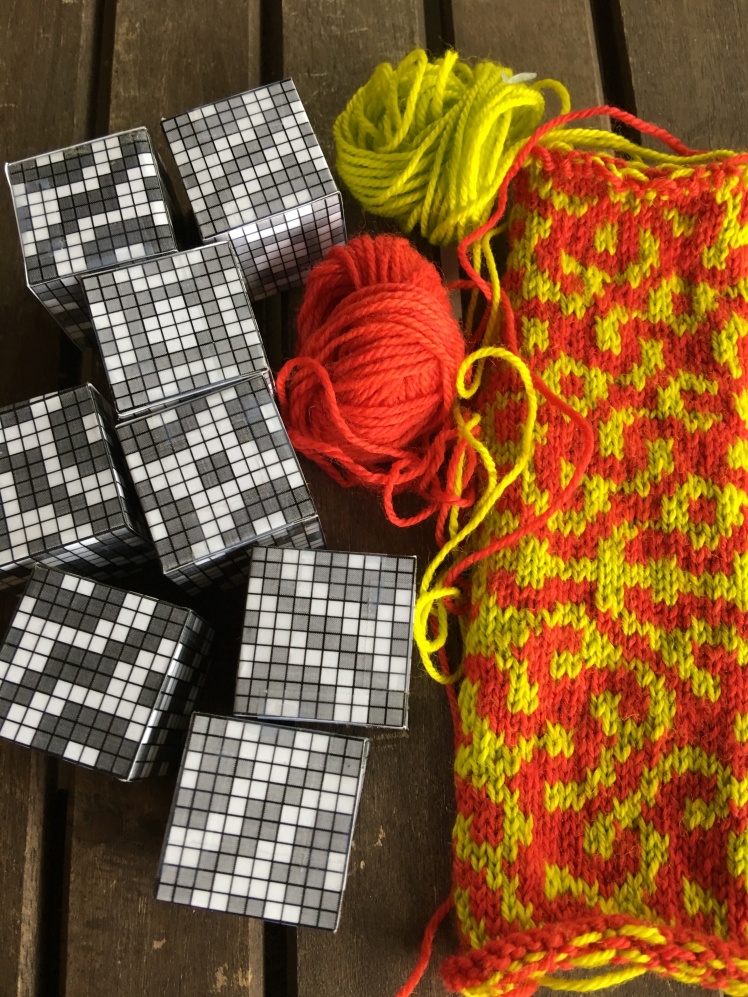
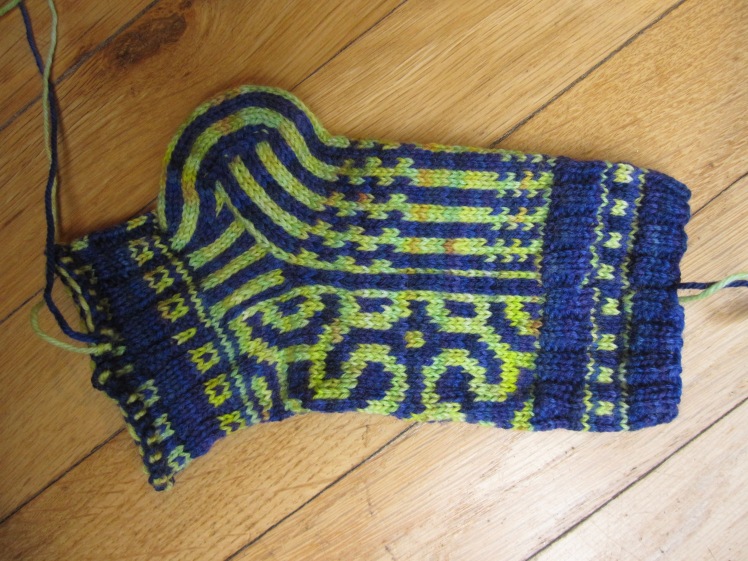


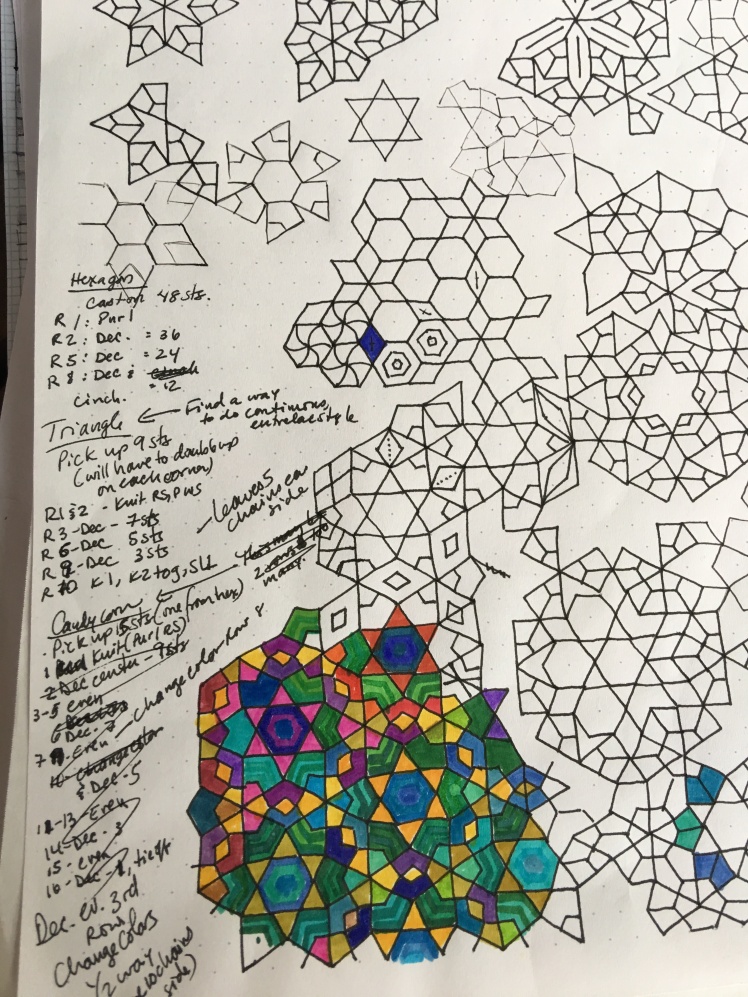







Brilliant interview I find it all magical I am one of the people that just follow instructions without a thought in my head so I always appreciate clear detailed ones because when I buy a pattern is because I want to knit exacatly that
LikeLike
Thank you, Monica! That’s what so great about Kirsten’s patterns: she has thought of everything and everything is there in her patterns. She’s a master at her craft.
LikeLike
I thoroughly enjoyed reading that Abby, I am almost stirred to return to my own diamond backs that are languishing at the bottom of my knitting bag.
LikeLike
Come back to them! They are going to be a rewarding triumph!
LikeLike
Wonderful interview! It helps make sense of a lot of things. I love that knitting can either be a complete exploration (the creative designer) where boundaries are pushed and people can truly ‘invent’. But also that other designers use some existing rules to invent new-from-old. Then other people can take a pattern and faithfully knit it up spotting the unclear bits (testers and tech editors), and those who can visually make it pop by using just the right yarn combination and colour. Almost as if we’re all part of a big creative team with many skills.
LikeLike
Well said! It’s part of the micro and macro perspectives that Kirsten mentioned.
LikeLike
I read the interview three times and every time i found new details to think about. Diamonds are definitely an endless source to design with.
Thank you for this inspiring post! I’llcertainly link to it in my next post on my blog.
LikeLike
I read the interview three times and every time i found new details to think about. Diamonds are definitely an endless source to design with.
Thank you for this inspiring post! I’llcertainly link to it in my next post on my blog.
LikeLike
Thank you for that, Michaela!
LikeLike
Great interview of a great designer!
LikeLike
Simply and totally fascinating to read! A meeting of great minds – and so full of creativity and originality and inspiration! Thanks to you both!
LikeLike
Thank you, Margie! I had a wonderful time talking to Kirsten and finding out how she does what she does. Have you looked at the post I just published about how I based a pullover on Kirsten’s sock pattern?
LikeLike
I think that a photo of your sweater somehow popped up on facebook and that took me to Ravelry and then and there I decided to get the sock pattern – when my yarn arrives I will dive in!
LikeLike
I hope you love it! What yarn did you order?
LikeLike